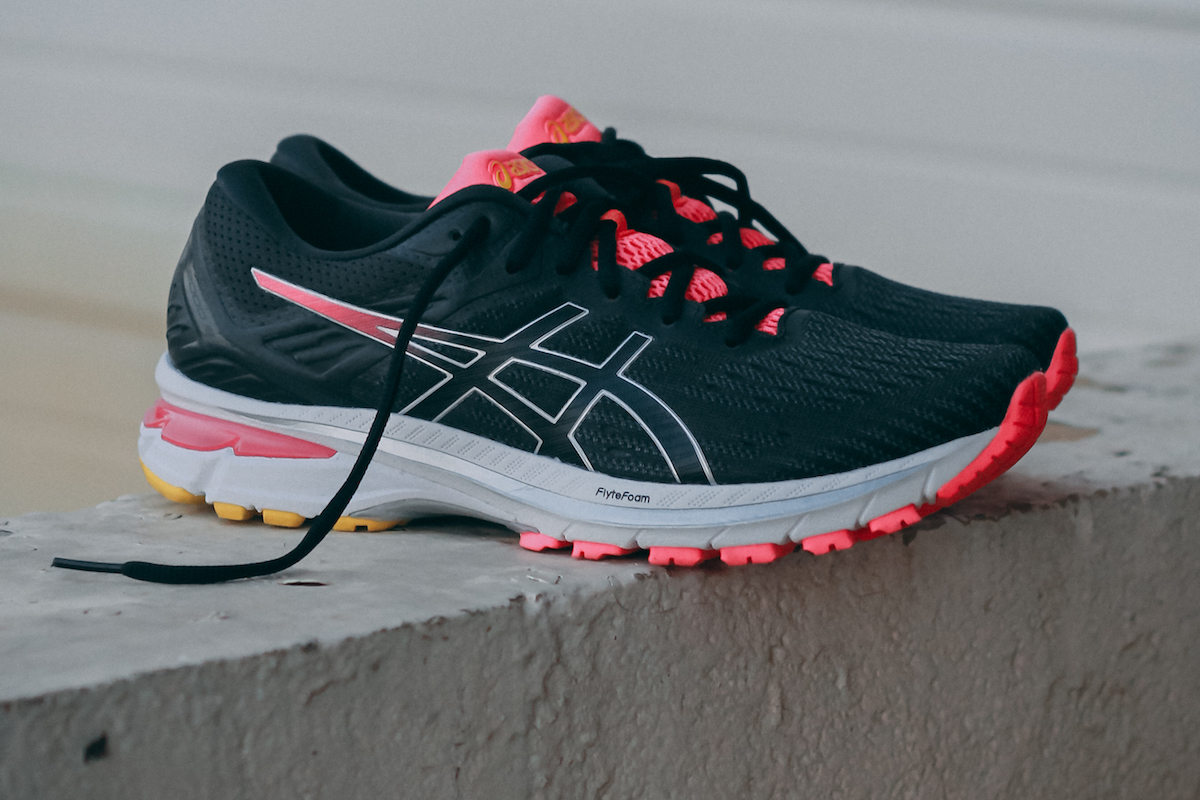
ROBBE: I’m gonna start by saying this– I’m always wary of shoes with a bunch of numbers and random letters for a name. Like they’re trying too hard to prove something, a la rapper Tekashi 6ix9ine. Think that’s a stretch? Exhibit A: The HOKA ONE ONE TenNine– it looks crazier than 6ix9ine’s face after a prison tattoo convention. I had never run in an ASICS stability shoe, and I’m not typically a stability runner, so I was fully prepared to give the ASICS GT-2000 9 one of those “it’s great for walking” reviews.
After all, snitches get stitches, and so do stability shoes (lots of them), but I was surprised to find out that the GT-2000 9 wasn’t clunky like most shoes of its kind. It wasn’t heavy, and best of all, I didn’t hate running in it, unlike most stability shoes.
That’s my quick and dirty intro (hopefully not as dirty as 6ix9ine’s dreads); I’ll step out of the way and let Adrienne drop some real knowledge on you now.
ADRIENNE: In the back corner of my closet lies a ‘race swag graveyard’ of sorts– old medals, awards, and things providing just enough sentimentality to justify keeping (but not hoarding!) from running days of the past. In this corner sits a pair of old-school ASICS GT-2000 series shoes. They are meshy and full of stitching and plastic everywhere, yet they still are glorious. Why, you ask? Because I ran my first marathon and BQ in them. Therefore, I cannot bring myself to get rid of them. Call it good juju or something like that. Enough about my 2008 glory days, now let’s talk about the 2020 version of these things, the GT-2000 9.
Sidebar-I received this pair during the middle of the GRIT summer distance project sponsored by Polar and ASICS, and found it fitting to put some hot, sweaty miles on the pavement wearing a pair of our partner shoe (I promise this didn’t affect my judgment). So how did they do? Let’s get GRITty…
Do you like ASICS? The classic, supportive, get-the-job-done daily trainer type ASICS? Then you will probably like this version of the brand’s moderate-stability staple. I think it does a good job connecting the old guard with touches of the new while not forgetting where it came and what it does. Like the simple, straightforward summer mileage challenge, a shoe like the GT-2000 fits the bill for pounding pavement day in day out. It’s like your college professor or engineer training partner; practical, steady, and detail-oriented. Stereotypes aside (but you know they’re true), let’s get to the basics.
Stability shoes nowadays tend to impress me far more than in the past. They’re lighter, more attractive, and most seem less directive and more suggestive in their ride. Previous generations of stability models always gave me weird aches and pains. Minus the early GT models of my early running career, running in anything with a post tended to shred my peroneal muscles and caused a mild phobia of this type of shoe. But enough of my issues, according to ASICS, the GT-2000 weighs in at a reasonable 7.8 oz for women and has a 10 mm drop (stack height 22 heel/12 toe). Nothing fancy here.
The upper is a one-piece, comfortable engineered mesh that has a nice feel upon step-in. Not too tight, not too sloppy and it seems to encase your foot nicely. The support features start here, with intelligent placement of the Tiger Stripes and seamless overlays that are barely noticeable to the eye (in my graphite gray/black pair, anyway), but seem to hold the foot in place well from the midfoot back.
For as much reinforcement on the outside of the shoe, I didn’t find it stifling, even in 80-plus degree July temperatures. The heel counter may look fairly modest compared to many of the other daily trainer models out there (looking at you, Saucony), but I encountered no heel slippage.
It has enough reinforcements toward the rear of the shoe that a Barcalounger heel counter probably is not needed. Laces are not too long and not too short, but like other ASICS models, such as the EvoRide, there a bit of excessive tongue action going on. Not uncomfortable, but thought it was noteworthy.
The midsole was and still is designed for shock absorption. This is an ideal situation for someone new to running, recently injured, or just need a little more protection for daily runs. Upfront, it’s all FlyteFoam and it seems to work beautifully. After running in the DS Trainer 25 and the GEL-Cumulus 22, I have developed an appreciation for the lower density, resilient, foam ASICS puts out. No, it won’t blow your mind, but it definitely keeps you comfortably moving down the road with some decent energy return.
Gel inserts sit in the heel and under the ball of the foot, you know, because ASICS, and this shoe seems to cancel vibration like one of those high-end tennis rackets. That analogy probably doesn’t work, but I’ve got nothing else. The rearfoot is where it gets a little busier. Besides the Gel and FlyteFoam, a firmer to the touch Dynamic DuoMax post still resides along the arch to– according to ASICS– “re-supinate the foot at midstance for a more efficient toe-off.” Working together with the still-present and effective (and bridge-like) Guidance Trussic System, your foot is guided toward a more natural gait cycle. You know, it keeps your s#^* more in line if you overpronate.
But what if you don’t overpronate? Actually, the set-up is not as intrusive as it sounds. While I noticed the Trusstic system some during landings, I didn’t feel anything forced or artificial. We can thank the flex grooves throughout the shoe for this. To finish things off, what is an ASICS daily trainer without some AHAR (ASICS High Abrasion Rubber)? There is plenty of it to ensure you get a good number of gritty miles in this shoe.
How does it ride? Honestly, I found it pretty nice. For as much tech going on, this is a pretty smooth stability shoe. No matter where you land, the guidance system and flex grooves provide smooth landings with some decent response. This is not an energy-sapping shoe, nor does it feel heavy and wear you down. This is not your rigid, slappy ASICS stability shoe of the past.
I found the ride most pleasant at moderate paces and distances, say 6-10 miles, but the shoe doesn’t seem to mind if you slow down or pick up the pace some. I tend to favor a forefoot strike when I get going, and the shoe feels really smooth and controlled upfront.
The back? Being a non-stability runner mostly, I did find heel striking to feel a bit constrictive, but that’s probably more of an Adrienne thing versus anyone else. Those who need heel stability, however, should be right at home with this offering. It can handle anything from an easy recovery run to tempo work and long runs. Or if you’re like me, you can run a marathon in them if you really want to.
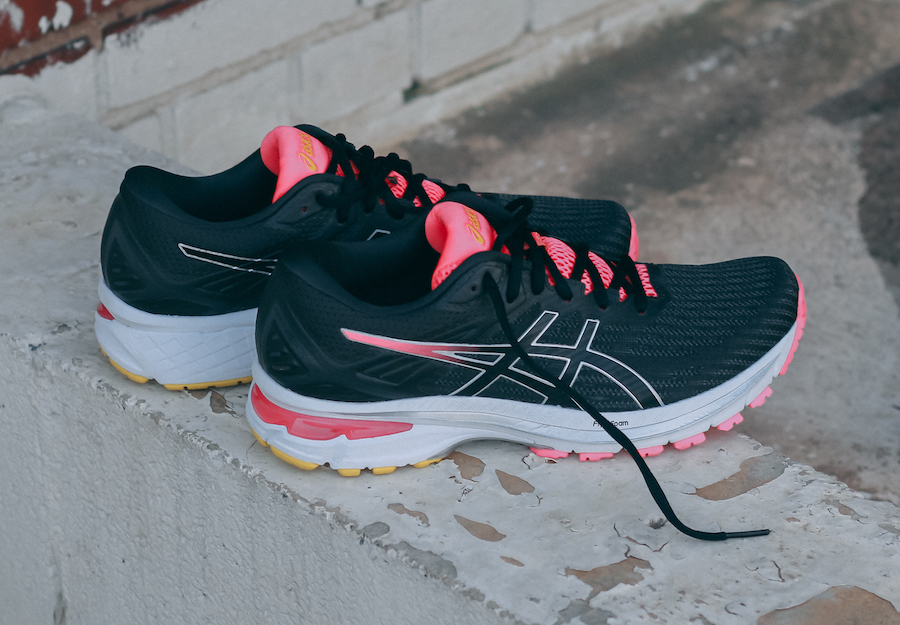
ROBBE: Like I said, I wasn’t exactly refreshing the FedEx tracking page in anticipation of this shoe. Hell, I even tried to figure out a way to not run in it based on the women’s colorway. I can wear 3” running shorts, but I guess I’m not progressive enough for hot pink ASICS.
The upper is as comfortable as you would expect from an ASICS upper. Plenty of stability features but solid cushion throughout the ankle collar. Lockdown is good, with just the right amount of room throughout, although the superfluous tongue created some issues (more on that later).
So I took them out for a few runs and wow– this ain’t a bad shoe, stability or otherwise. It’s surprisingly light for the way it looks. At 9 oz. for a US M9.0, it can run, but will still provide a lot of cushion and structure.
The FlyteFoam midsole in rearfoot Gel isn’t going to change the world, but it gets the job done as far as providing a comfortable ride at any distance.
I felt super secure in the shoe, especially taking turns. The forefoot flex grooves work in tandem with the outsole rubber to provide excellent traction on any surface, especially while cornering. I was surprised at how well the shoe picked up too. For a stability shoe, this may be my most favorite one to date. It does all the things you’d like a solid, neutral daily trainer to do, and a little bit more.
ADRIENNE: For a moderate stability trainer, this shoe runs fairly smooth and has a nice, natural forefoot flex to it. I found it to run pretty light as well– the GT-2000 certainly feels lighter than it looks. Speaking of looks, it’s not a bad-looking shoe at all. It sports a sleek, still-classic look. With Nike and HOKA going all-out with extreme aesthetics, those wanting something quieter but effective may like these. Flex grooves are visible on the forefoot sidewalls and when I see this in a daily trainer, I smile because I know these shoes will work with my gait cycle. I tend to sit at around 180 steps per minute and found it easy to get into a nice rhythm of the GT-2000 9 and I found picking up the pace fairly easy. Due to the stability features of the shoe, my feet felt like they were on autopilot, which I found nice when I was tired or on an easy run where I’d rather be thinking about something other than my foot strike. And in a world where hugs are hard to come by, the supportive upper gives your foot a nice one and doesn’t let go. These shoes also seem durable as all get out; I still see any signs of wear on the outsole. AHAR for the win.
Shop ASICS – Men Shop ASICS – Women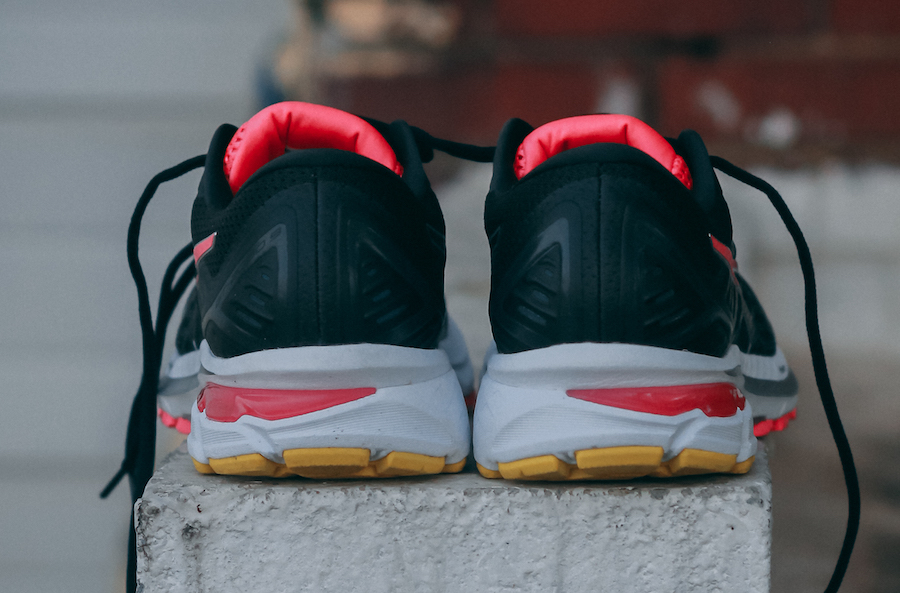
ROBBE: I mean, let’s be real. ASICS has made some great strides in the design department in 2020, but this looks like what you would call a mid-aughts ASICS shoe. It’s not the worst, but it’s pretty basic. It’s technically not a “bad” thing, since you need some models to just get the job done and cater to people who want a normal looking shoe. That’s fine if your whole inventory doesn’t look like that.
Since I’m cursed with a men’s size 7.5 shoe, I had to take on a women’s model for my review. Full disclosure, the pink lemonade/black colorway was a little much, so I stripped out the pink laces and threw in some old Brooks Launch 5 laces. And then I murdered out my entire running kit to make sure my bases were covered.
Side note: I’ve seen some other colorways, and they look much better. So keep an eye out.
Now, in terms of the actual shoe? Not too much bad, although the tongue is too puffy. I mean, it’s a shoe tongue, not a North Face winter coat. The lacing structure also got bunchy underneath the top part of the tongue, forced to congregate because of the eyelet setup. It wasn’t a huge issue, but I had to double-check because I thought I’d laced them wrong.
I would say the Trusstic system in the midfoot could use some updating, but I already know that’s something ASICS is working on, so I ain’t gonna ding them for it.
ADRIENNE: This is coming from a neutrally biased place, but as much as I liked the feel of the forefoot, my rearfoot felt a bit caged and landings felt somewhat forced. The Trusstic System seems a little outdated for the current times, and on occasion, it was noticeable on the run. And that puffy tongue. It has nothing to do with performance but yeah…
Shop ASICS – Men Shop ASICS – Women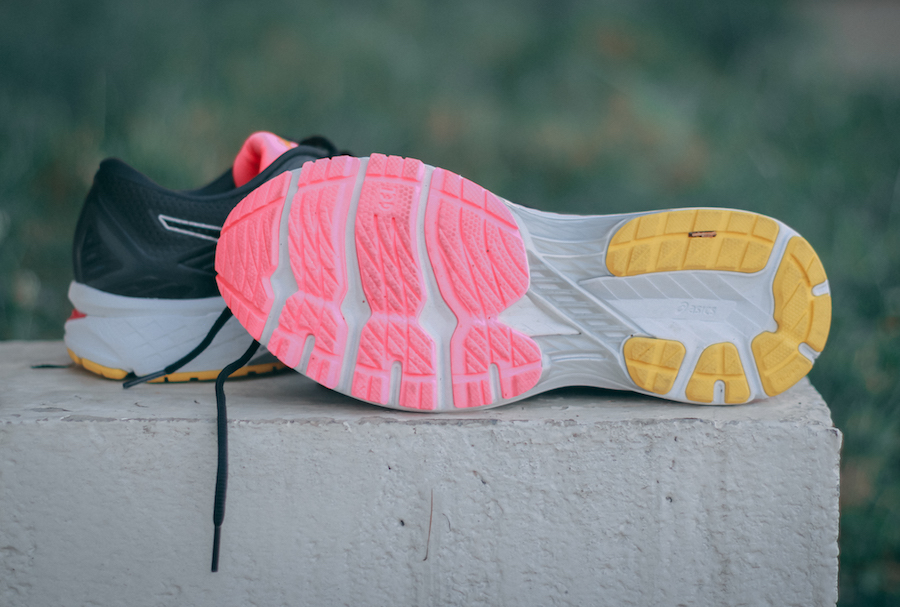
ROBBE: You probably came to this review looking for a good stability shoe, and I gotta say– if you want something a bit lighter and more nimble than the Kayano 27 tanker, then this is the shoe for you. It does all of the things you need a shoe to do. You’ll certainly get a ton of enjoyable miles for your money.
ADRIENNE: The GT-2000 9 sounds like a safe yet sporty sedan (or, according to Robbe, a SoundCloud rapper), and it performs like one too. ASICS’ latest stability offering should meet the needs of new runners needing a shoe that can do most things pretty well, this may be your shoe. I’m impressed with ASICS staying true to itself and still evolving models like this because not everyone needs the AlphaFly in their lives. Supportive, stable, and fairly lively, this is a solid daily trainer pick for the overpronator. It won’t change the world, but it will make your world a stable one. Lastly, who else keeps milestone shoes in their closet. Anyone??
The ASICS GT-2000 9 releases 9/1 for $120. You can pick it up at Running Warehouse (featuring free 2-day shipping and 90-day returns) by using the shop link below.
Shop ASICS – Men Shop ASICS – Women
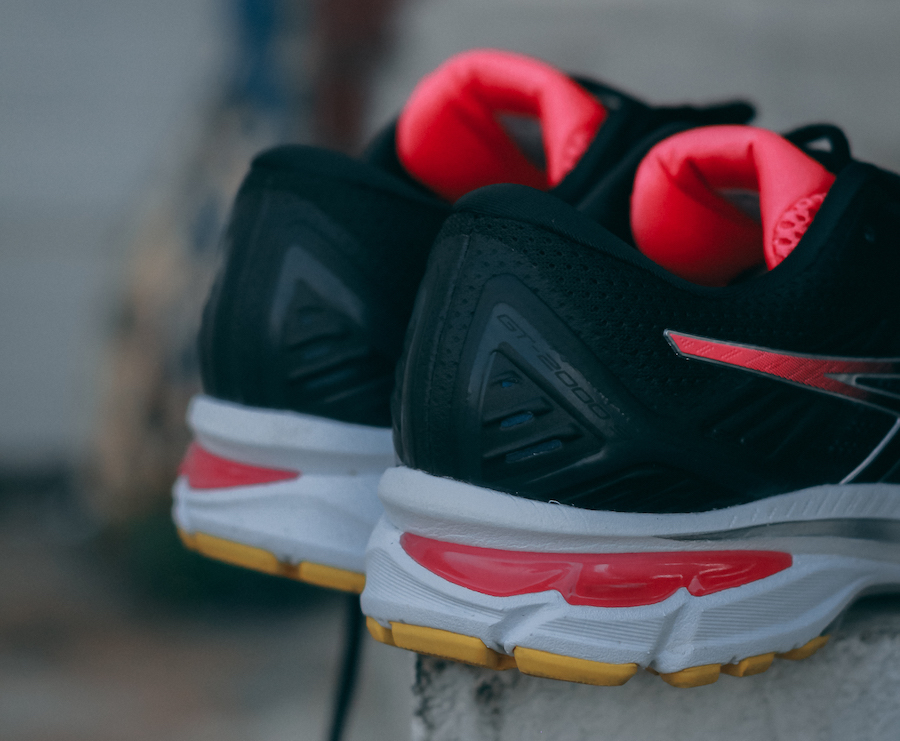
Have something to say? Leave a Comment
Everybody of your team who tests a stability shoe quotes that he or she does not need (and therefore likes) stability shoes…
Wouldn’t it be much easier to let someone test those shoes who really NEEDs them?
I mean, you would never let someone test a Trail shoe who just run on concrete or test a speed shoe on a beginner with a 10 min mile…
There are folks out there (like me) who really get injured when they run more than 5 miles in neutral shoes so this would be a very helpful.
In the end, a Gt 2000 is sold a thousand times more than an Alphfly.